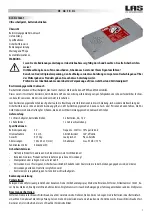
29
4.4 Load Balancing
Load Balancing is applied in the high density wireless environment. It can balance the APs
load and guarantee the reasonable access of the clients to APs. Therefore, the wireless
resources and bandwidth of each AP can be used fairly.
The following example is used to illustrate the working process of load balancing.
Figure 4-7
Topology
CAP1
Wireless Controller
Client
CAP2
Client number: 20
Client number: 16
The client is within the wireless range of CAP1 and CAP2. The client requests to connect to
CAP1 and the following two conditions are met:
1 The client number of CAP1 has reached or exceeded the maximum number that the
load balancing set ( 20 as an example).
2 The client is also in the coverage of other CAPs. And the difference of the connected
client number between CAP1 and one of the other CAPs is greater than the difference
threshold set in load balancing (4 as an example, 20-16≥4).
Due to load balancing, AC will reject the client’s request to connect to CAP1 and instead
connect the client to other CAPs with a smaller load. Thus, the performance of the whole
network is improved.
If the client requests to connect to CAP1 continually, and the request fail number exceeds
the maximum fail number set in load balancing, CAP1 will accept the connecting request of
the client.
If the signal strength of the client is smaller than the RSSI threshold, it will not count to the
total number of clients in load balancing.
















































